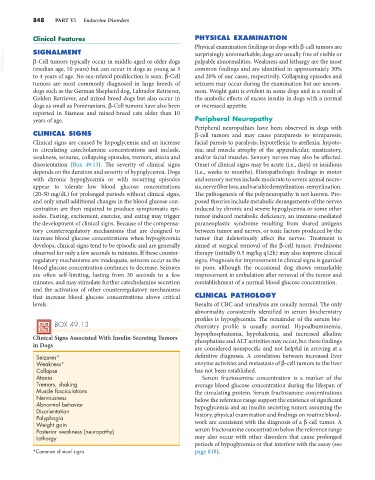Page 876 - Small Animal Internal Medicine, 6th Edition
P. 876
848 PART VI Endocrine Disorders
Clinical Features PHYSICAL EXAMINATION
Physical examination findings in dogs with β-cell tumors are
SIGNALMENT
VetBooks.ir β-Cell tumors typically occur in middle-aged or older dogs surprisingly unremarkable; dogs are usually free of visible or
palpable abnormalities. Weakness and lethargy are the most
(median age, 10 years) but can occur in dogs as young as 3
and 20% of our cases, respectively. Collapsing episodes and
to 4 years of age. No sex-related predilection is seen. β-Cell common findings and are identified in approximately 30%
tumors are most commonly diagnosed in large breeds of seizures may occur during the examination but are uncom-
dogs such as the German Shepherd dog, Labrador Retriever, mon. Weight gain is evident in some dogs and is a result of
Golden Retriever, and mixed breed dogs but also occur in the anabolic effects of excess insulin in dogs with a normal
dogs as small as Pomeranians. β-Cell tumors have also been or increased appetite.
reported in Siamese and mixed-breed cats older than 10
years of age. Peripheral Neuropathy
Peripheral neuropathies have been observed in dogs with
CLINICAL SIGNS β-cell tumors and may cause paraparesis to tetraparesis;
Clinical signs are caused by hypoglycemia and an increase facial paresis to paralysis; hyporeflexia to areflexia; hypoto-
in circulating catecholamine concentrations and include, nia; and muscle atrophy of the appendicular, masticatory,
weakness, seizures, collapsing episodes, tremors, ataxia and and/or facial muscles. Sensory nerves may also be affected.
disorientation (Box 49.13). The severity of clinical signs Onset of clinical signs may be acute (i.e., days) or insidious
depends on the duration and severity of hypoglycemia. Dogs (i.e., weeks to months). Histopathologic findings in motor
with chronic hypoglycemia or with recurring episodes and sensory nerves include moderate to severe axonal necro-
appear to tolerate low blood glucose concentrations sis, nerve fiber loss, and variable demyelination-remyelination.
(20-30 mg/dL) for prolonged periods without clinical signs, The pathogenesis of the polyneuropathy is not known. Pro-
and only small additional changes in the blood glucose con- posed theories include metabolic derangements of the nerves
centration are then required to produce symptomatic epi- induced by chronic and severe hypoglycemia or some other
sodes. Fasting, excitement, exercise, and eating may trigger tumor-induced metabolic deficiency, an immune-mediated
the development of clinical signs. Because of the compensa- paraneoplastic syndrome resulting from shared antigens
tory counterregulatory mechanisms that are designed to between tumor and nerves, or toxic factors produced by the
increase blood glucose concentrations when hypoglycemia tumor that deleteriously affect the nerves. Treatment is
develops, clinical signs tend to be episodic and are generally aimed at surgical removal of the β-cell tumor. Prednisone
observed for only a few seconds to minutes. If these counter- therapy (initially 0.5 mg/kg q12h) may also improve clinical
regulatory mechanisms are inadequate, seizures occur as the signs. Prognosis for improvement in clinical signs is guarded
blood glucose concentration continues to decrease. Seizures to poor, although the occasional dog shows remarkable
are often self-limiting, lasting from 30 seconds to a few improvement in ambulation after removal of the tumor and
minutes, and may stimulate further catecholamine secretion reestablishment of a normal blood glucose concentration.
and the activation of other counterregulatory mechanisms
that increase blood glucose concentrations above critical CLINICAL PATHOLOGY
levels. Results of CBC and urinalysis are usually normal. The only
abnormality consistently identified in serum biochemistry
profiles is hypoglycemia. The remainder of the serum bio-
BOX 49.13 chemistry profile is usually normal. Hypoalbuminemia,
hypophosphatemia, hypokalemia, and increased alkaline
Clinical Signs Associated With Insulin-Secreting Tumors phosphatase and ALT activities may occur, but these findings
in Dogs
are considered nonspecific and not helpful in arriving at a
Seizures* definitive diagnosis. A correlation between increased liver
Weakness* enzyme activities and metastasis of β-cell tumors to the liver
Collapse has not been established.
Ataxia Serum fructosamine concentration is a marker of the
Tremors, shaking average blood glucose concentration during the lifespan of
Muscle fasciculations the circulating protein. Serum fructosamine concentrations
Nervousness below the reference range support the existence of significant
Abnormal behavior hypoglycemia and an insulin secreting tumor, assuming the
Disorientation
Polyphagia history, physical examination and findings on routine blood-
Weight gain work are consistent with the diagnosis of a β-cell tumor. A
Posterior weakness (neuropathy) serum fructosamine concentration below the reference range
Lethargy may also occur with other disorders that cause prolonged
periods of hypoglycemia or that interfere with the assay (see
*Common clinical signs. page 818).

